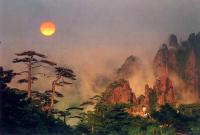History of Mount Wuyi
The earliest human occupation in the Mount Wuyi (Wuyishan) region antedates the Xia Dynasty (late 3rd millennium BC). During the Shang and Zhou Dynasties (16th to 3rd centuries BC) it came within the region of minority aboriginal tribes. During the Qin Dynasty (late 3rd century BC) there was considerable migration of tribal groups into the region.
With the consolidation of the Chinese Empire by the Han Dynasty (late 3rd century BC to early 3rd century AD) Wuyi was fully incorporated into the state system, its ruler becoming a vassal of the Han Emperor. A large town was built nearby in the 1st century BC, which served as the capital and administrative centre of the region.
It was at this time that Mount Wuyi acquired its status as a sacred mountain. In the centuries that followed many holy men and scholars were attracted to it, and monasteries and academies were established in beautiful natural surroundings conducive to study and contemplation. To ensure that the beauty of the environment was not degraded, Tang Emperor Xuan Zong issued a decree in AD 748 forbidding fishing and the felling of trees, a sanction that survives to the present day.
Mount Wuyi was first a centre of Taoism, when many temples and study centres were established, but Buddhism also developed alongside, and by the 17th century had largely superseded Taoism. It was in the Song Dynasty that Zhu Xi evolved the doctrines of Neo-Confucianism, from his famous Wuyi Jingshe Academy, work on which began in 1183. The intellectual renown of Mount Wuyi has continued to attract scholars, sages, artists, and writers throughout subsequent ages.













